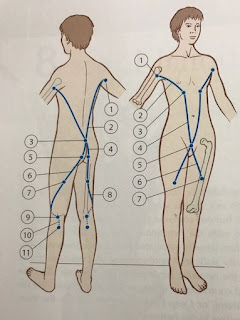Last week, we wrote about how Covid-19 may cause
frozen shoulder (also known as adhesive capsulitis), so I thought I'd follow up with a post on how we can increase or at least maintain shoulder flexion range during the first and second stage of
frozen shoulder.
 |
| Table slide |
Research (Rabin et al, 2021) suggest that doing the 'table slide' and 'forward bow' rather than self assisted flexion will give better results for shoulder flexion and less pain. Byron demonstrates the table slide above. Seat slightly forward comfortably on a standard chair (ususally 45 cm high) with your forearms resting on a higher table (80cm). Interlock your hands together and lean forward by sliding your forearms until you reach your tolerable stretch.
 |
| Forward bow |
For the forward bow, in a standing position, you need to place both palms with elbows straight on a table. Next you need to step back slightly, lower your chest towards the floor until you reach maximum tolerable range.
 |
| Assissted flexion |
Of course you can still do the self assissted flexion. But it may elicit more pain and the range you attain is usually less. This can be done in standing or even lying down. Thiviyan (above) is holding a stick with both elbows straight while using the unaffected arm to lift the stick into maximum tolerable shoulder flexion.
Some physiotherapists may suggest using a rope and pulley anchored over the top of a door using the unaffected arm to pull the affected side up. Research also suggests the rope and pulley method is less effective and more painful.
How do we, at Physio Solutions and Sports Solutions, treat frozen shoulder?
I already revealed this in a previous post. We get best results treating the hip and the arm lines. Remember I wrote previously that our arms and shoulders are connected to our hips?
Have a look at the connections again above and below.
Don't put up with pain and limited range. we are here to help you.
Reference
Rabin A, Maman E, Dolkart O et al (2021). Regaining Shoulder Motion Among Patients With Shoulder Pathology - Are All Exercises Equal? Shoulder and Elbow. 0(0): 1-8. DOI: 10.1177/17585732211067161










No comments:
Post a Comment